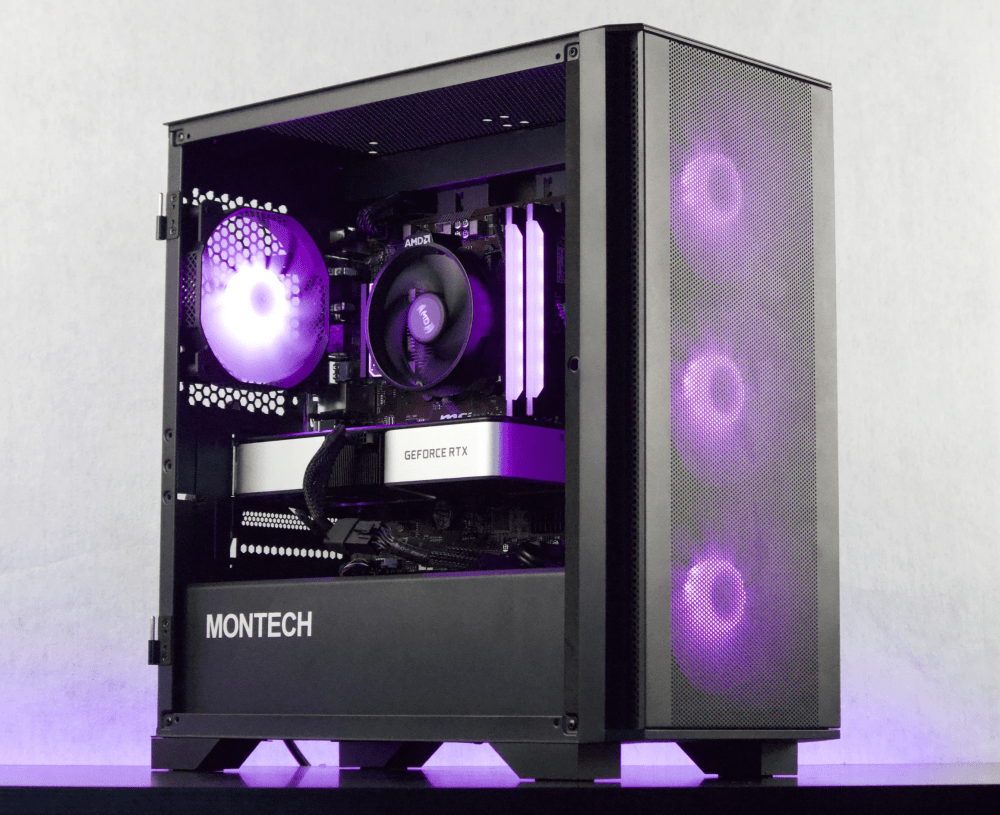A clean and well-maintained GPU (Graphics Processing Unit) is essential for optimal performance and longevity of your computer. Over time, dust, dirt, and debris can accumulate on the GPU's surface, fans, and heat sinks, leading to overheating, reduced performance, and even system crashes. To prevent these issues and ensure your GPU operates at its best, regular cleaning is necessary. In this blog post, we will guide you through the step-by-step process of cleaning your GPU effectively and safely. From understanding the importance of a clean GPU to gathering the necessary supplies and taking safety precautions, we'll cover it all. So, let's dive in and learn how to keep your GPU in top shape for smooth and uninterrupted gaming or graphic-intensive tasks.
Understanding the Importance of a Clean GPU
A clean GPU is crucial for maintaining the overall performance and lifespan of your computer. The GPU is responsible for rendering graphics, processing complex calculations, and running resource-intensive applications. Over time, dust, dirt, and debris can accumulate on the surface of the GPU, as well as its cooling components such as fans and heat sinks.
When dust and debris build up on the GPU, it restricts airflow and hampers the cooling system's effectiveness. This can lead to overheating, which not only affects the GPU's performance but also poses a potential risk to other vital components of your computer.
Here are some key reasons why it's important to keep your GPU clean:
1. Enhanced Performance
A clean GPU operates at lower temperatures, allowing it to function optimally. When dust clogs the cooling system, the GPU can overheat, causing it to throttle its performance to prevent damage. By regularly cleaning your GPU, you can ensure that it runs at its full potential, delivering smooth graphics and faster processing speeds.
2. Increased Lifespan
Heat is one of the biggest enemies of electronic components. Excessive heat can shorten the lifespan of your GPU and other hardware components. By keeping your GPU clean and maintaining proper airflow, you can reduce the risk of overheating and prolong the longevity of your investment.
3. Preventing System Instability
An overheating GPU can trigger system crashes, freezes, and unexpected shutdowns. When the GPU reaches unsafe temperatures, it may activate built-in protection mechanisms that halt the system's operation to prevent damage. Regular cleaning helps prevent these issues and ensures a stable and reliable computing experience.
4. Improved Energy Efficiency
When a GPU is clogged with dust, it requires more power to operate efficiently, resulting in increased energy consumption. By cleaning the GPU regularly, you can optimize its energy efficiency, reducing power consumption and potentially lowering your electricity bills.
5. Maintaining Warranty Coverage
Many GPU manufacturers include cleaning and maintenance as part of their warranty terms. Neglecting to clean your GPU regularly might void the warranty if damage occurs due to overheating caused by excessive dust buildup. Taking proper care of your GPU ensures that you can avail of warranty support if needed.
Now that we understand the importance of a clean GPU, let's move on to the next section and prepare ourselves for the cleaning process by gathering the necessary supplies and taking appropriate safety precautions.
Preparing to Clean Your GPU
Before diving into the process of cleaning your GPU, it's important to prepare yourself and gather the necessary supplies. This section will outline why regular cleaning is necessary, the supplies you'll need for the cleaning process, and the safety precautions you should take to ensure a smooth and risk-free cleaning experience.
Why Regular Cleaning is Necessary
Regular cleaning of your GPU is essential to prevent dust and debris buildup, which can lead to various issues such as overheating, reduced performance, and system instability. By incorporating regular cleaning into your computer maintenance routine, you can prolong the lifespan of your GPU and maintain optimal performance.
Supplies Needed for Cleaning
To clean your GPU effectively, you'll need the following supplies:
-
Compressed Air Canister: This is a key tool for removing dust and debris from hard-to-reach areas such as the GPU fans and heat sinks. Make sure to use a canister specifically designed for cleaning electronics.
-
Isopropyl Alcohol: Isopropyl alcohol is commonly used for cleaning electronic components. It helps to remove stubborn dirt, thermal paste residue, and grime from the GPU.
-
Microfiber Cloth: A soft, lint-free microfiber cloth is ideal for wiping down the GPU surface and removing any remaining residue after cleaning.
-
Cleaning Brushes: Small, soft-bristled brushes are useful for cleaning delicate components and reaching tight spaces.
-
Thermal Paste: If you're planning to reapply thermal paste after cleaning, make sure to have a high-quality thermal paste on hand.
-
Screwdriver: Depending on your GPU model, you may need a screwdriver to remove the GPU from your computer.
Safety Precautions Before Cleaning
When dealing with electronic components, it's important to take proper safety precautions to avoid any damage or injury. Here are some safety measures to consider before cleaning your GPU:
-
Power Off and Unplug: Before starting the cleaning process, ensure that your computer is powered off and unplugged. This will protect you from electrical shock and prevent any accidental damage to your hardware.
-
Ground Yourself: Static electricity can damage sensitive electronic components. To prevent static discharge, ground yourself by touching a grounded metal surface, such as a metal part of your computer case, before handling the GPU.
-
Work in a Well-Ventilated Area: Cleaning your GPU can release dust particles into the air. It's best to work in a well-ventilated area or consider wearing a dust mask to avoid inhaling the particles.
-
Take Anti-Static Precautions: To minimize the risk of static electricity damaging your GPU, consider using an anti-static wrist strap or mat during the cleaning process. These help to discharge any static buildup from your body.
By understanding the importance of cleaning your GPU, gathering the necessary supplies, and taking appropriate safety precautions, you're now ready to dive into the step-by-step guide on how to clean your GPU effectively.
Step-by-Step Guide to Cleaning Your GPU
Cleaning your GPU may seem like a daunting task, but with the right approach and guidance, it can be a straightforward process. This section will provide you with a step-by-step guide to effectively clean your GPU, covering the removal of the GPU from your computer, cleaning the GPU surface, cleaning the GPU fans, and cleaning the GPU heat sinks.
1. Removing the GPU from Your Computer
-
Power off your computer and disconnect all cables.
-
Open your computer case by removing the side panel. Refer to your computer's manual or manufacturer's website for specific instructions.
-
Locate the GPU in your computer. It is typically inserted into a PCIe slot on the motherboard.
-
Before removing the GPU, make sure to discharge any static electricity by touching a grounded metal surface.
-
Carefully remove any screws or brackets securing the GPU to the case.
-
Press the PCIE slot release lever then gently grasp the GPU by its edges and lift it straight out of the PCIe slot. Avoid touching any sensitive components or connectors.
2. Cleaning the GPU Surface
-
Place the GPU on an anti-static mat or a clean, non-static surface.
-
Use a compressed air canister to blow away loose dust and debris from the GPU's surface. Hold the canister upright and use short bursts to avoid liquid residue.
-
If there are stubborn stains or grime on the GPU surface, dampen a microfiber cloth with a small amount of isopropyl alcohol.
-
Gently wipe the surface of the GPU in a circular motion until the stains are removed. Avoid applying excessive pressure to prevent damage.
-
Allow the GPU to air dry completely before moving on to the next step.
3. Cleaning the GPU Fans
-
Locate the fans on the GPU. They are usually situated around the heat sink.
-
Use the compressed air canister to blow away dust and debris from the fan blades, ensuring that you reach all angles.
-
Hold the fan blades in place with your finger to prevent them from spinning. Blowing air onto a spinning fan can cause damage.
-
Use a soft-bristled brush to gently dislodge any remaining dust from the fan blades and surrounding areas.
-
Once the fans are clean, use the compressed air canister again to blow away any loosened debris.
4. Cleaning GPU Heat Sinks
-
Locate the heat sinks on the GPU. They are usually metal fins attached to the GPU's core.
-
Use the compressed air canister to blow away dust and debris from the heat sinks. Pay close attention to the spaces between the fins.
-
If necessary, use a soft-bristled brush to gently remove any stubborn dirt or debris.
-
Once the heat sinks are clean, use the compressed air canister to blow away any loosened particles.
5. Reinstalling Your Cleaned GPU
-
Check the GPU's connectors for any dust or debris. Use the compressed air canister to blow away any particles.
-
Align the GPU with the PCIe slot on the motherboard.
-
Gently insert the GPU into the slot, applying even pressure until it is fully seated. Make sure the bracket aligns with the case openings.
-
Secure the GPU in place by replacing the screws or brackets that were removed during the removal process.
-
Close the computer case and reconnect all cables.
Congratulations! You have successfully cleaned your GPU. In the next section, we will discuss how to maintain your GPU to ensure it remains clean and performs optimally over time.
Maintaining Your GPU
Cleaning your GPU is just one part of the equation when it comes to keeping it in top shape. Regular maintenance is key to ensure optimal performance and longevity. This section will cover important practices to maintain your GPU and keep it clean over time.
1. Regularly Inspect for Dust and Damage
Make it a habit to visually inspect your GPU for any signs of dust accumulation or physical damage. Check the GPU's surface, fans, and heat sinks regularly. If you notice any significant dust buildup or damage, it may be necessary to clean the GPU more frequently or seek professional assistance.
2. Schedule Regular Cleaning
Set a schedule for cleaning your GPU to prevent dust and debris from causing performance issues. Depending on your environment and usage, cleaning every 3 to 6 months is generally recommended. However, if you live in a particularly dusty or humid area or use your computer for intensive tasks, more frequent cleaning may be necessary.
3. Keeping the Computer's Environment Clean
Maintaining a clean environment around your computer can help reduce the amount of dust and debris that enters the system. Here are some tips:
-
Place your computer in a dust-free area, away from carpets, pets, or areas with high pollen levels.
-
Use air filters or purifiers in the room where your computer is located.
-
Regularly clean the area around your computer to minimize dust and dirt accumulation.
-
Consider using dust covers for your computer case to further protect it from dust.
4. Monitor GPU Temperatures
Keep an eye on your GPU's temperatures using monitoring software or manufacturer-provided utilities. High temperatures can indicate poor cooling or excessive dust buildup. If you notice consistently high temperatures, it may be necessary to clean your GPU or upgrade your cooling system.
5. Update GPU Drivers
Regularly update your GPU drivers to ensure compatibility with the latest software and to benefit from performance optimizations and bug fixes. Check the manufacturer's website or use automatic driver update software to keep your GPU drivers up to date.
By following these maintenance practices, you can keep your GPU clean, cool, and functioning optimally for an extended period of time. Remember, a well-maintained GPU not only delivers better performance but also helps protect your investment.
Ready to level up your game? Check out Jawa for the best deals on PC gaming hardware





